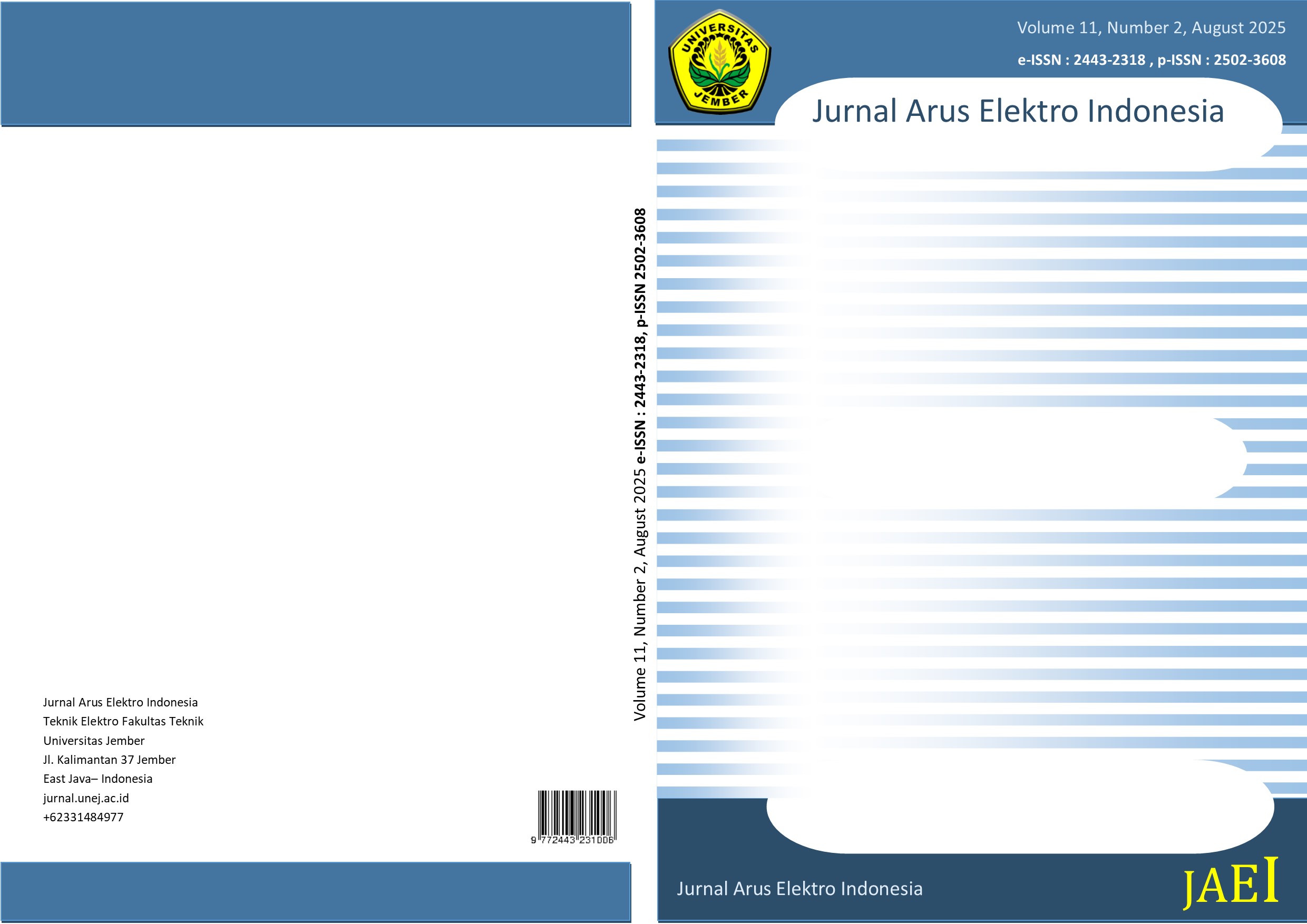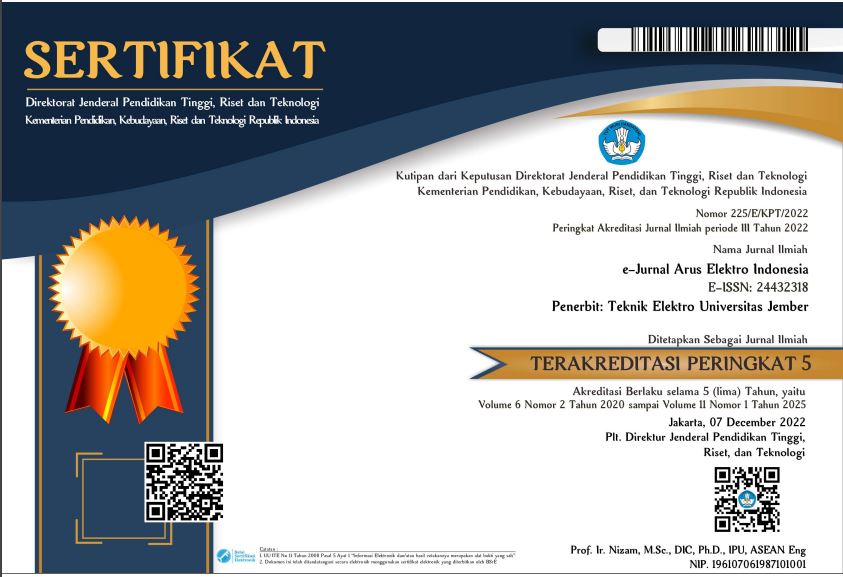Analisis Perbandingan Pengukuran Konsumsi Daya Motor BLDC 350W Melalui Pengukuran Dynamometer dan Pengujian On-road
DOI:
https://doi.org/10.19184/jaei.v11i2.51570Abstract
Testing the overall performance of electric vehicles requires extensive on-road testing with varied conditions. Considering the amount of time and effort required for on-road testing, using a dynamometer as a testing tool can be an alternative. In this research, a dynamometer is modeled so that the load used is equivalent to the load on the urban car of the University of Jember. The purpose of this study is to analyze and validate the dynamometer in accordance with actual road testing conditions. The research was conducted by comparing power consumption measurements obtained from on-road testing with those obtained using a dynamometer. In each test, variations in PWM usage strategies were also applied to determine which PWM variations result in the most efficient power consumption. The study shows that the difference in power measurement results between the on-road testing method and the dynamometer method has a maximum difference of 7.58%. The resulting discrepancy is relatively small, leading to the conclusion that testing with the dynamometer method can represent direct testing. Another result obtained is that the variation of using constant PWM achieves the most efficient energy consumption.
Downloads
References
[1] J. A. Sanguesa, V. Torres-Sanz, P. Garrido, F. J. Martinez, and J. M. Marquez-Barja, “A Review on Electric Vehicles: Technologies and Challenges,” Smart Cities, vol. 4, no. 1, pp. 372–404, Mar. 2021, doi: 10.3390/smartcities4010022.
[2] A. Sukmayadi, S. Riyadi, and S. Witaradya, “PEDOMAN KONTES MOBIL HEMAT ENERGI TAHUN 2023.” Balai Pengembangan Talenta Indonesia Kementerian Pendidikan, Kebudayaan, Riset, dan Teknologi, Aug. 2023.
[3] D. des Ramadhana, “RANCANG BANGUN DYNAMOMETER SEBAGAI ALAT UKUR EFISIENSI DAYA DAN KARAKTERISTIK KINERJA PADA MOTOR BRUSHLESS DC.” Universitas Jember, 2022.
[4] G. Prasad, N. S. Ramya, P. V. N. Prasad, and G. T. R. Das, “Modelling and Simulation Analysis of the Brushless DC Motor by using MATLAB,” vol. 1, no. 5, 2012.
[5] D. Mohanraj et al., “A Review of BLDC Motor: State of Art, Advanced Control Techniques, and Applications,” IEEE Access, vol. 10, pp. 54833–54869, 2022, doi: 10.1109/ACCESS.2022.3175011.
[6] L. R. Reddy, A. Sharma, P. Magdam, and K. Shah, “Electric Vehicle Motor Tests and Standards in India: A Review,” in Intelligent Infrastructure in Transportation and Management, J. Shah, S. S. Arkatkar, and P. Jadhav, Eds., Singapore: Springer Singapore, 2022, pp. 227–237.
[7] Z. Wei et al., “Design and energy efficiency analysis of a pure fuel cell vehicle for Shell eco racer,” Int J Energy Res, vol. 43, no. 7, pp. 2963–2973, Jun. 2019, doi: 10.1002/er.4487.
[8] K. Wiratkasem and S. Pattana, “The effect of motorcycle tyre rolling resistance coefficient on the saving of fuel consumption,” Energy Reports, vol. 7, pp. 248–252, Sep. 2021, doi: 10.1016/j.egyr.2021.06.042.
[9] Harris Fadzillah Zainal Abidin, Md Tasyrif Abdul Rahman, Abdul Hamid Adom, Mohd Ridzuan Mohd Jamir, Sufi Suraya Halim, and Mohd Al Hafiz Mohd Nawi, “An Analysis of Urban Vehicle Body Aerodynamics Using Computational Fluid Dynamics for the Shell Eco-Marathon Challenge,” ARASET, vol. 30, no. 2, pp. 75–91, Apr. 2023, doi: 10.37934/araset.30.2.7591.
[10] S. Hanapi, A. S. Tijani, A. H. A. Rahim, and W. A. N. W. Mohamed, “Comparison of A Prototype PEM Fuel Cell Powertrain Power Demand and Hydrogen Consumption Based on Inertia Dynamometer and On-Road Tests,” Energy Procedia, vol. 79, pp. 73–81, Nov. 2015, doi: 10.1016/j.egypro.2015.11.480.
[11] J. Shah, S. S. Arkatkar, and P. Jadhav, Eds., Intelligent Infrastructure in Transportation and Management: Proceedings of i-TRAM 2021. in Studies in Infrastructure and Control. Singapore: Springer Singapore, 2022. doi: 10.1007/978-981-16-6936-1.
Downloads
Published
Issue
Section
License
Copyright (c) 2025 Jurnal Arus Elektro Indonesia

This work is licensed under a Creative Commons Attribution-ShareAlike 4.0 International License.
Sebagai penulis yang sesuai naskah dan atau atas nama semua penulis, saya menjamin bahwa :
- Naskah yang diajukan adalah karya asli saya/kami sendiri.
- Naskah belum dipublikasikan dan tidak sedang diajukan atau dipertimbangkan untuk diterbitkan di tempat lain.
- Teks, ilustrasi, dan bahan lain yang termasuk dalam naskah tidak melanggar hak cipta yang ada atau hak-hak lainnya dari siapa pun.
- Sebagai penulis yang sesuai, saya juga menjamin bahwa "JAEI Editor Journal" tidak akan bertanggung jawab terhadap semua klaim hak cipta dari pihak ketiga atau tuntutan hukum yang dapat diajukan di masa depan, dan bahwa saya akan menjadi satu-satunya orang yang akan bertanggung jawab dalam kasus tersebut.
- Saya juga menjamin bahwa artikel tersebut tidak mengandung pernyataan memfitnah atau melanggar hukum.
- Saya/kami tidak menggunakan metode yang melanggar hukum atau materi selama penelitian.
- Saya/kami memperoleh semua izin hukum yang berkaitan dengan penelitian,
- Saya/kami berpegang pada prinsip-prinsip etika selama penelitian.
- Saya/kami bersedia apabila artikel kami dipublikasikan oleh tim redaksi JAEI






